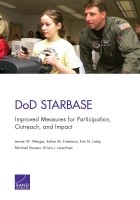| 来源类型 | Research Reports
|
| 规范类型 | 报告
|
| DOI | https://doi.org/10.7249/RR2160
|
| ISBN | 9781977401045
|
| 来源ID | RR-2160-OSD
|
| DoD STARBASE: Improved Measures for Participation, Outreach, and Impact |
| Jennie W. Wenger; Esther M. Friedman; Erin N. Leidy; Michael Vasseur; Kristin J. Leuschner; John D. Winkler
|
| 发表日期 | 2018
|
| 出版年 | 2018
|
| 页码 | 98
|
| 语种 | 英语
|
| 结论 |
- There is strong evidence that STARBASE serves a relatively disadvantaged population, with the exception of Native American/Alaskan Native students, who are less likely to be present in the districts served. Considering the locations of these populations during any future expansion of STARBASE could result in the program reaching a wider range of disadvantaged youth.
- To date, STARBASE programs' outreach efforts are largely local and consist primarily of specific relationships between individual STARBASE programs and relevant local organizations. These efforts have the potential to improve community relations and public perceptions of the military. Programs currently appear not to make much use of social media.
- Social media campaigns sponsored by the Department of Defense (DoD) are likely to reach an audience that is already comfortable with the department and military service. While social media is not currently a major source of influencer impressions of the military, existing data suggest that social media is viewed as a relatively trustworthy source of information, and one that is likely to become increasingly relevant in the future.
- STARBASE may be especially well situated to create positive outreach. Overall, DoD youth programs are located in areas with relatively high levels of trust in the military, but in the cases of STARBASE and National Guard Youth ChalleNGe, the difference in trust between areas with and without such programs is very small, suggesting that some of the programs are located in areas with lower levels of trust in the military.
|
| 摘要 |
- Track levels of disadvantage. Future tracking of the levels of disadvantage among the students and communities served by STARBASE will provide a way to document the extent to which the program continues to serve students from disadvantaged schools.
- Explore the use of increased social media outreach for Department of Defense (DoD) youth programs. Currently, STARBASE programs have very modest social media outreach efforts, mostly run by individual programs through Facebook accounts. A centralized social media campaign could have the potential to increase awareness of and support for STARBASE, and potentially for other DoD programs
- Centrally manage DoD's youth programs. Measuring outreach efforts poses a substantial challenge, and more work is necessary to develop and test appropriate measures of outreach and their long-term impact. If the youth programs are considered as a group, placement decisions could be made to maximize both access to the programs and potential outreach.
- Work toward a better understanding of the relationships between youth programs, military institutional presence, and the public's perceptions of DoD. Establishing improved measures of outreach could assist DoD in measuring the extent to which youth programs achieve this aspect of their missions. One method of measuring effectiveness would be to conduct a survey of a random subsample of the population, asking questions about awareness and impressions of various aspects of military outreach programs, or to adapt an existing survey for this purpose.
|
| 主题 | Disadvantaged Students
; Elementary Education
; STEM Education
|
| URL | https://www.rand.org/pubs/research_reports/RR2160.html
|
| 来源智库 | RAND Corporation (United States)
|
| 引用统计 |
|
| 资源类型 | 智库出版物
|
| 条目标识符 | http://119.78.100.153/handle/2XGU8XDN/108873
|
推荐引用方式
GB/T 7714 |
Jennie W. Wenger,Esther M. Friedman,Erin N. Leidy,et al. DoD STARBASE: Improved Measures for Participation, Outreach, and Impact. 2018.
|
|
文件名:
|
x1539982733278.jpg
|
|
格式:
|
JPEG
|

|
文件名:
|
RAND_RR2160.pdf
|
|
格式:
|
Adobe PDF
|
除非特别说明,本系统中所有内容都受版权保护,并保留所有权利。